Tensile Failure Behaviors and Theories of Carbon/Glass Hybrid Interlayer and Intralayer Composites
Abstract
1. Introduction
2. Materials and Methods
2.1. Materials
2.1.1. Interlayer Hybrid Structures
2.1.2. Intralayer Hybrid Structures
2.2. Tensile Testing
3. Tensile Process and Failure Behaviors of Interlayer and Intralayer Hybrid Composites
3.1. Failure Behaviors of Interlayer and Intralayer Hybrid Composites with the Hybrid Ratio C:G = 1:1
3.2. Failure Behaviors of Interlayer and Intralayer Hybrid Composites with the Hybrid Ratio C:G = 1:2
3.3. Failure Behaviors of Interlayer and Intralayer Hybrid Composites with the Hybrid Ratio C:G = 1:3
3.4. Failure Behaviors of Interlayer and Intralayer Hybrid Composites with the Hybrid Ratio C:G = 1:4
3.5. Failure Theory of Hybrid Composites
3.5.1. Synergistic Effect
3.5.2. Damage Acceleration Effect
3.5.3. Stress–Strain Decay of Hybrid Composites
4. Tensile Properties of Interlayer and Intralayer Hybrid Composites
4.1. Tensile Properties of Interlayer Hybrid Composites
4.2. Tensile Properties of Intralayer Hybrid Composites
4.3. Comparison of Theoretical and Experimental Tensile Strength forInterlayer and Intralayer Hybrid Composites
| Hybrid tensile modulus derived from ROM (GPa); | |
| : | Tensile modulus of carbon fiber (GPa); |
| : | Tensile modulus of glass fiber (GPa); |
| : | The fiber volume fraction of carbon fiber composites; |
| : | The fiber volume fraction of glass fiber composites. |
| : | The stress of hybrid composites (MPa) |
| The fiber volume fraction of carbon composites; | |
| The fiber volume fraction of glass composites; | |
| : | Tensile modulus of carbon fiber (GPa); |
| : | Tensile modulus of glass fiber (GPa); |
| : | The strain of hybrid composites. |
5. Conclusions
Funding
Institutional Review Board Statement
Informed Consent Statement
Data Availability Statement
Conflicts of Interest
References
- Swolfs, Y.; Gorbatikh, L.; Verpoest, I. Fibre hybridisation in polymer composites: A review. Compos. Part A Appl. Sci. Manuf. 2014, 67, 181–200. [Google Scholar] [CrossRef]
- Saidane, E.H.; Scida, D.; Assarar, M.; Sabhi, H.; Ayad, R. Hybridisation effect on diffusion kinetic and tensile mechanical behaviour of epoxy based flax–glass composites. Compos. Part A Appl. Sci. Manuf. 2016, 87, 153–160. [Google Scholar] [CrossRef]
- Gu, H.B.; Liu, C.T.; Zhu, J.H.; Gu, J.W.; Wujcik, E.K.; Shao, L.; Wang, N.; Wei, H.; Scaffaro, R.; Zhang, J.X.; et al. Introducing advanced composites and hybrid materials. Adv. Compos. Hybrid Mater. 2018, 1, 1–5. [Google Scholar] [CrossRef]
- Ghabussi, A.; Habibi, M.; NoormohammadiArani, O.; Shavalipour, A.; Moayedi, H.; Safarpour, H. Frequency characteristics of a viscoelastic graphene nanoplatelet–reinforced composite circular microplate. J. Vib. Control. 2021, 27, 101–118. [Google Scholar] [CrossRef]
- Huo, J.F.; Zhang, G.P.; Ghabussi, A.; Habibi, M. Bending analysis of FG-GPLRC axisymmetric circular/annular sector plates by considering elastic foundation and horizontal friction force using 3D-poroelasticity theory. Compos. Struct. 2021, 276, 114438. [Google Scholar] [CrossRef]
- Ghabussi, A.; Ashrafi, N.; Shavalipour, A.; Hosseinpour, A.; Habibi, M.; Moayedi, H.; Babaei, B.; Safarpour, H. Free vibration analysis of an electro-elastic GPLRC cylindrical shell surrounded by viscoelastic foundation using modified length-couple stress parameter. Mech. Based Des. Struct. Mach. 2021, 49, 738–762. [Google Scholar] [CrossRef]
- Mishnaevsky, L.; Dai, G.M. Hybrid carbon/glass fiber composites: Micromechanical analysis of structure–damage resistance relationships. Comput. Mater. Sci. 2014, 81, 630–640. [Google Scholar] [CrossRef]
- Celik, E.; Sacmaozu, G.; Irez, A.B. Development of carbon-glass fiber reinforced hybrid composites: Applications in offshore wind turbine blades. In Proceedings of the 2021 Annual Conference on Experimental and Applied Mechanics, Online, 14–17 June 2021; pp. 17–22. [Google Scholar]
- Zhao, W.Z.; Pei, N.; Xu, C.G. Experimental study of carbon/glass fiber-reinforced hybrid laminate composites with torsional loads by using acoustic emission and Micro-CT. Compos. Struct. 2022, 290, 115541. [Google Scholar] [CrossRef]
- Ku, H.; Wang, H.; Pattarachaiyakoop, N.; Trada, M. A review on the tensile properties of natural fiber reinforced polymer composites. Compos. B. Eng. 2011, 42, 856–873. [Google Scholar] [CrossRef]
- Nossa, I.S.; Bohórquez, O.; Pertuz, A.; Acevedo, H.G.S.; González-Estrada, O.A. Tensile mechanical properties of composite materials with continuous fiber produced by additive manufacturing. J. Phys. Conf. Ser. 2019, 1386, 012008. [Google Scholar] [CrossRef]
- Mu, X.N.; Cai, H.N.; Zhang, H.M.; Fan, Q.B.; Zhang, Z.H.; Wu, Y.; Ge, Y.X.; Wang, D.D. Interface evolution and superior tensile properties of multi-layer graphene reinforced pure Ti matrix composite. Mater. Des. 2018, 140, 431–441. [Google Scholar] [CrossRef]
- Swolfs, Y.; McMeeking, R.M.; Verpoest, I.; Gorbatikh, L. The effect of fibre dispersion on initial failure strain and cluster development in unidirectional carbon/glass hybrid composites. Compos. Part A Appl. Sci. Manuf. 2015, 69, 279–287. [Google Scholar] [CrossRef]
- Sapozhnikov, S.B.; Swolfs, Y.; Lomov, S.V. Mode I and II interlaminar critical energy release rates in all-carbon interlayer unidirectional fibre-hybrids based on ultrahigh-modulus and high-strength fibres. Compos. Struct. 2020, 236, 111886. [Google Scholar] [CrossRef]
- Wang, A.N.; Liu, X.G.; Yue, Q.R.; Xian, G.J. Tensile properties hybrid effect of unidirectional flax/carbon fiber hybrid reinforced polymer composites. J. Mater. Res. Technol. 2023, 24, 1373–1389. [Google Scholar] [CrossRef]
- Tavares, R.P.; Melro, A.R.; Bessa, M.A.; Turon, A.; Liu, W.K.; Camanho, P.P. Mechanics of hybrid polymer composites: Analytical and computational study. Comput. Mech. 2016, 57, 405–421. [Google Scholar] [CrossRef]
- Li, W.D.; Lin, C.H. Effect of CF/BF interlaminated hybrid structure on composite properties. Thermosetting Resin 2009, 05, 39–43. [Google Scholar]
- Zhou, G.M.; Liang, Z.Q.; Zhao, Q. Experiment research on mechanicar properties of C/G interlaminar hybrid composite. Aerosp. Mater. Technol. 2004, 34, 21–25. [Google Scholar]
- Chiang, M.Y.M.; Wang, X.F.; Schultheisz, C.R.; He, J.M. Prediction and three-dimensional Monte-Carlo simulation for tensile properties of unidirectional hybrid composites. Compos. Sci. Technol. 2005, 65, 1719–1727. [Google Scholar] [CrossRef]
- Zeng, J.F.; Wang, T.W.; Qiu, Z.M.; Qiao, S.R. A study on tensile and compressive properties of F-12 aramid fiber and carbon fiber hybrid composites. Aerosp. Mater. Technol. 2001, 31, 19–23. [Google Scholar]
- Subagia, I.D.G.A.; Kim, Y.; Tijing, L.D.; Kim, C.S.; Shon, H.K. Effect of stacking sequence on the flexural properties of hybrid composites reinforced with carbon and basalt fibers. Compos. B. Eng. 2014, 58, 251–258. [Google Scholar] [CrossRef]
- Buehler, M.J.; Rabu, P.; Taubert, A. Advanced hybrid materials: Design and applications. Eur. J. Inorg. Chem. 2012, 2012, 5092–5093. [Google Scholar] [CrossRef]
- Dong, A.Q.; Duan, Y.X.; Tang, X.X.; Wang, Y.F.; Tan, K.L. Study on layer sequence of unidirectional CF/GF hybrid fiber composites. In Proceedings of the 17th International Conference on Composite Materials, Beijing, China, 12–15 October 2012. [Google Scholar]
- Li, Y.; Sun, Z. Study on the mechanical properties of glass/ramie fiber reinforced hybrid composites. J. Mater. Eng. 2009, 70–74. [Google Scholar]
- Pandya, K.S.; Veerraju, C.; Naik, N.K. Hybrid composites made of carbon and glass woven fabrics under quasi-static loading. Mater. Des. 2011, 32, 4094–4099. [Google Scholar] [CrossRef]
- Dong, C.S.; Davies, I.J. Flexural and tensile moduli of unidirectional hybrid epoxy composites reinforced by S-2 glass and T700S carbon fibres. Mater. Des. 2014, 54, 893–899. [Google Scholar] [CrossRef]
- Ebrahimnezhad-Khaljiri, H.; Eslami-Farsani, R.; Akbarzadeh, E. Effect of interlayer hybridization of carbon, Kevlar, and glass fibers with oxidized polyacrylonitrile fibers on the mechanical behaviors of hybrid composites. Proc. Inst. Mech. Eng. Part C 2019, 234, 1823–1835. [Google Scholar] [CrossRef]
- Khosravani, M.R.; Weinberg, K. Characterization of sandwich composite T-joints under different ageing conditions. Compos. Struct. 2018, 197, 80–88. [Google Scholar] [CrossRef]
- Elangovan, H.; Rajamohan, V. Dynamic characterization of tapered composite sandwich plate with honeycomb core: Numerical and experimental investigations. Thin Wall Struct. 2022, 178, 109515. [Google Scholar] [CrossRef]
- Alsaadi, M.; Erkliğ, A.; Alrawi, H. Effect of S-glass fabric on the mechanical characteristics of a hybrid carbon/aramid fabric reinforced epoxy composites. Mater. Res. Express 2017, 4, 055304. [Google Scholar] [CrossRef]
- Karahan, M.; Karahan, N. Influence of weaving structure and hybridization on the tensile properties of woven carbon-epoxy composites. J. Reinf. Plast. Compos. 2013, 33, 212–222. [Google Scholar] [CrossRef]
- Júnior, C.Z.P.; Carvalho, L.H.d.; Fonseca, V.M.; Monteiro, S.N.; d’Almeida, J.R.M. Analysis of the tensile strength of polyester/hybrid ramie–cotton fabric composites. Polym. Test. 2004, 23, 131–135. [Google Scholar] [CrossRef]
- Fukuda, H.; Chou, T.-W. Monte Carlo Simulation of the Strength of Hybrid Composites. J. Compos. Mater. 1982, 16, 371–385. [Google Scholar] [CrossRef]
- Czél, G.; Jalalvand, M.; Wisnom, M.R. Design and characterisation of advanced pseudo-ductile unidirectional thin-ply carbon/epoxy–glass/epoxy hybrid composites. Compos. Struct. 2016, 143, 362–370. [Google Scholar] [CrossRef]
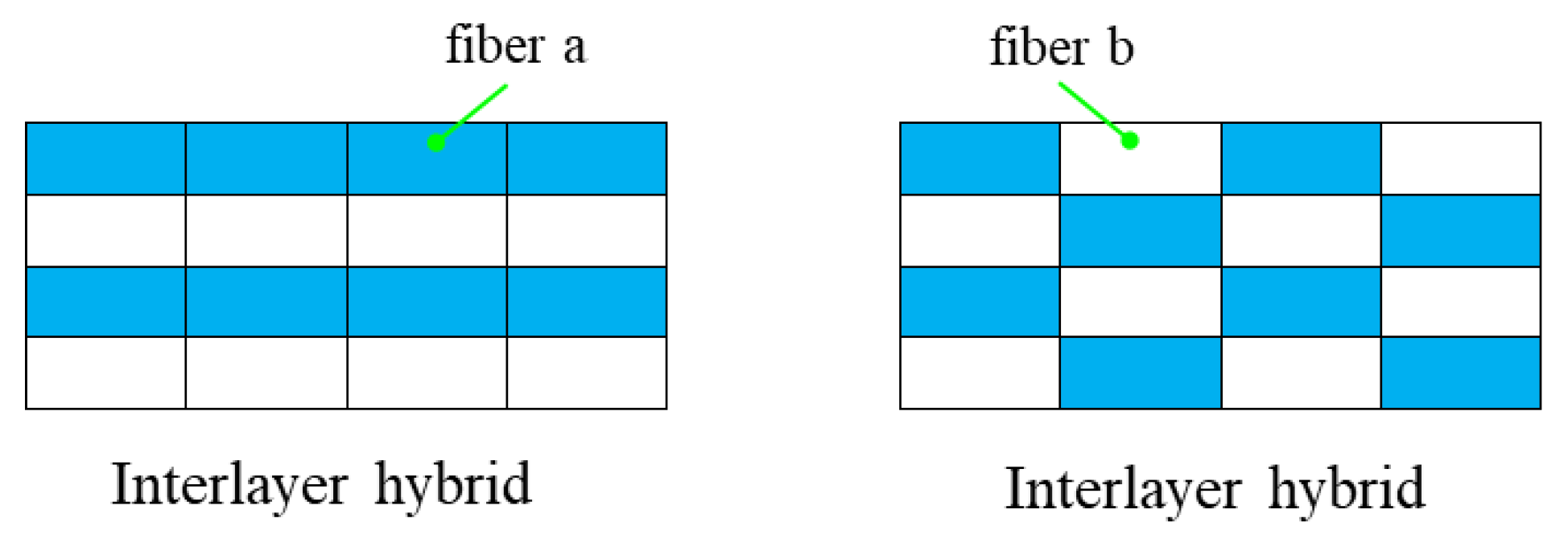



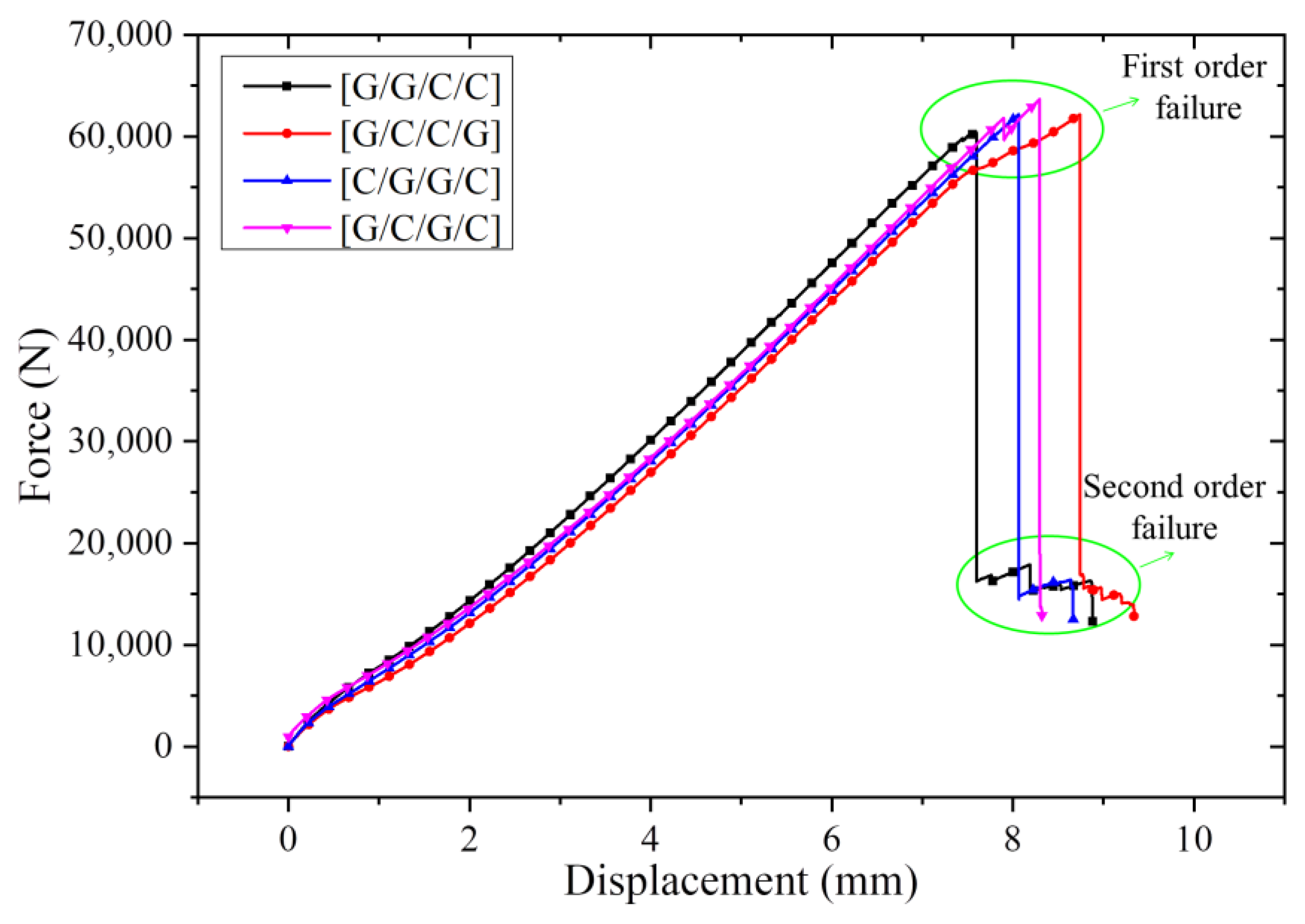
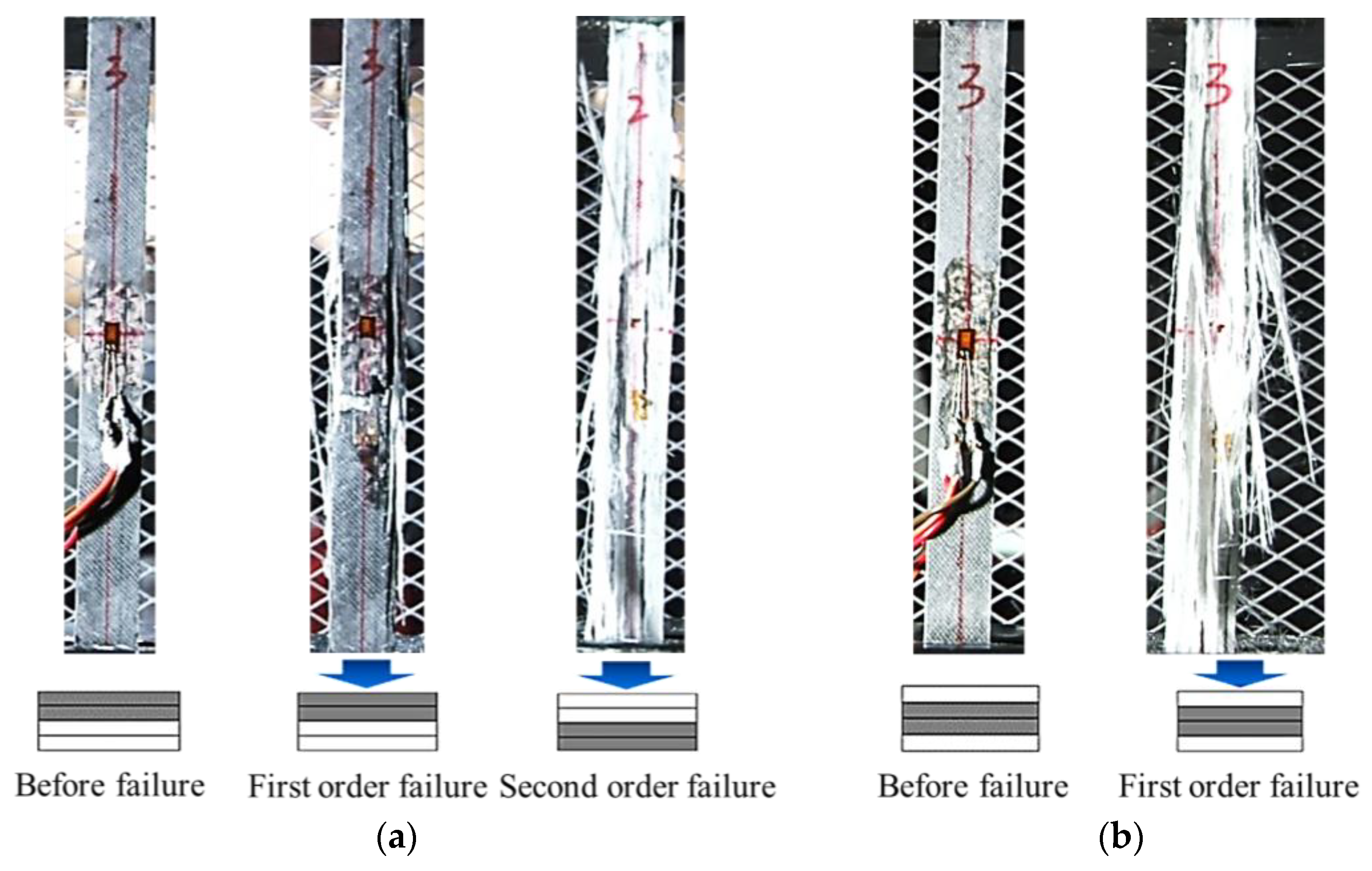
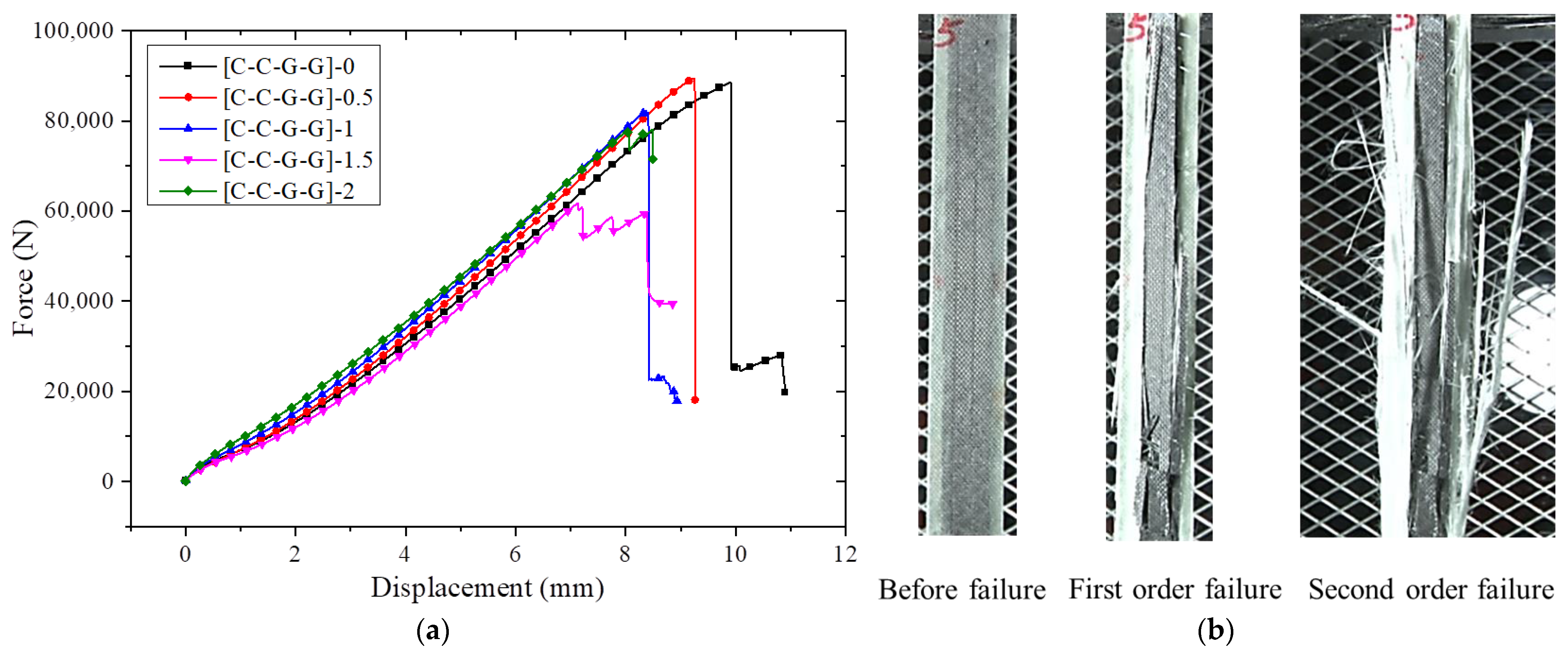
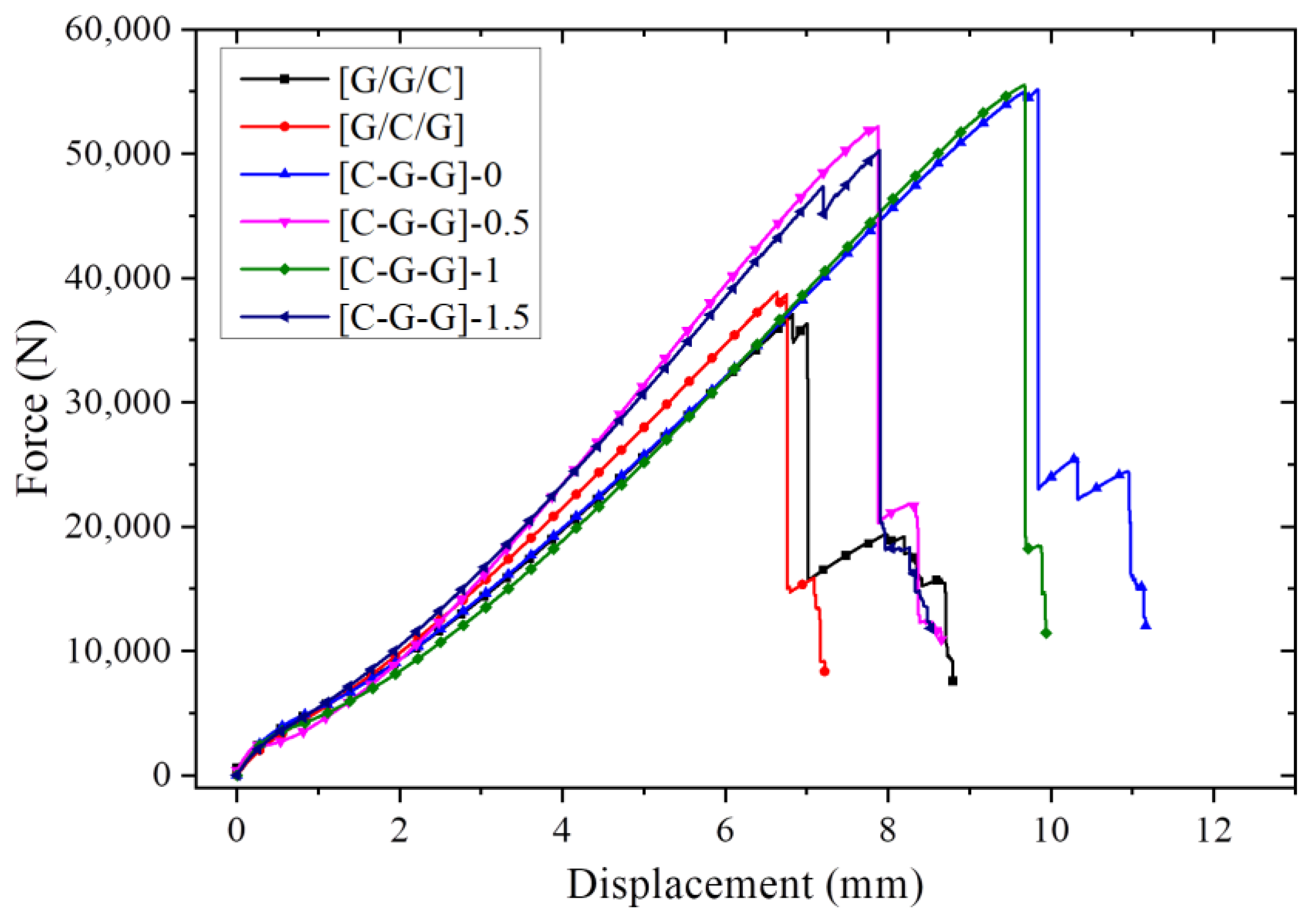
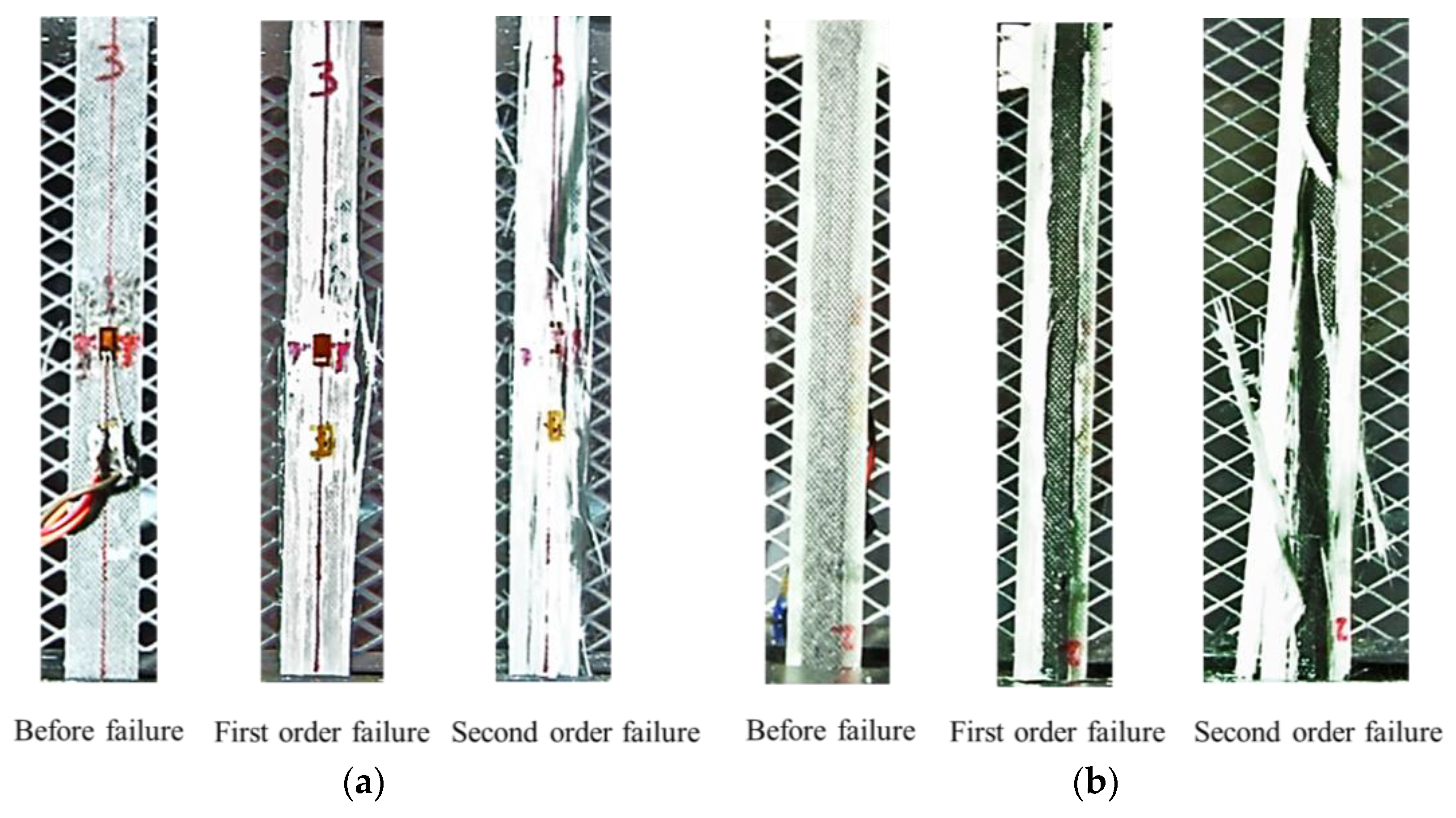
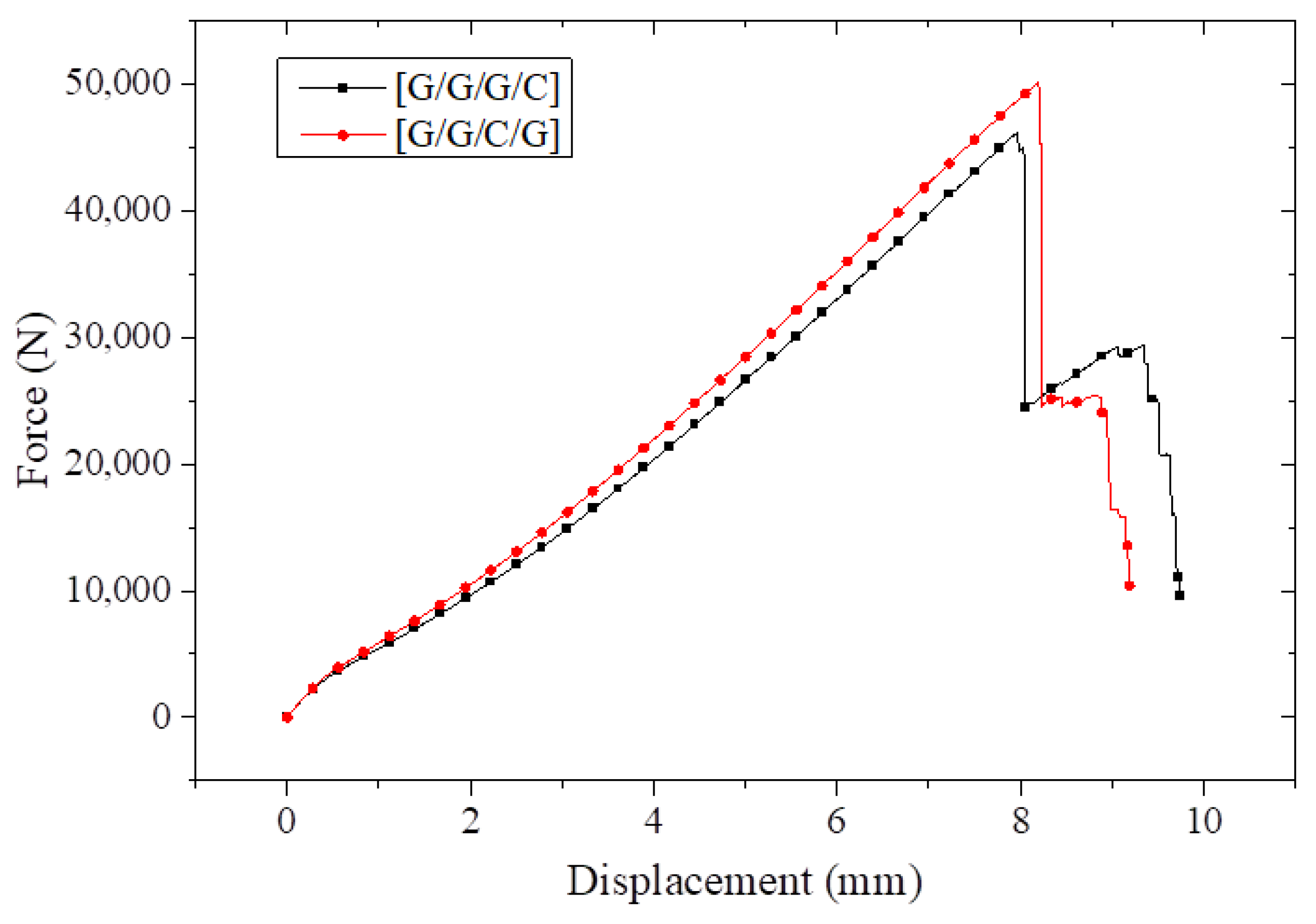
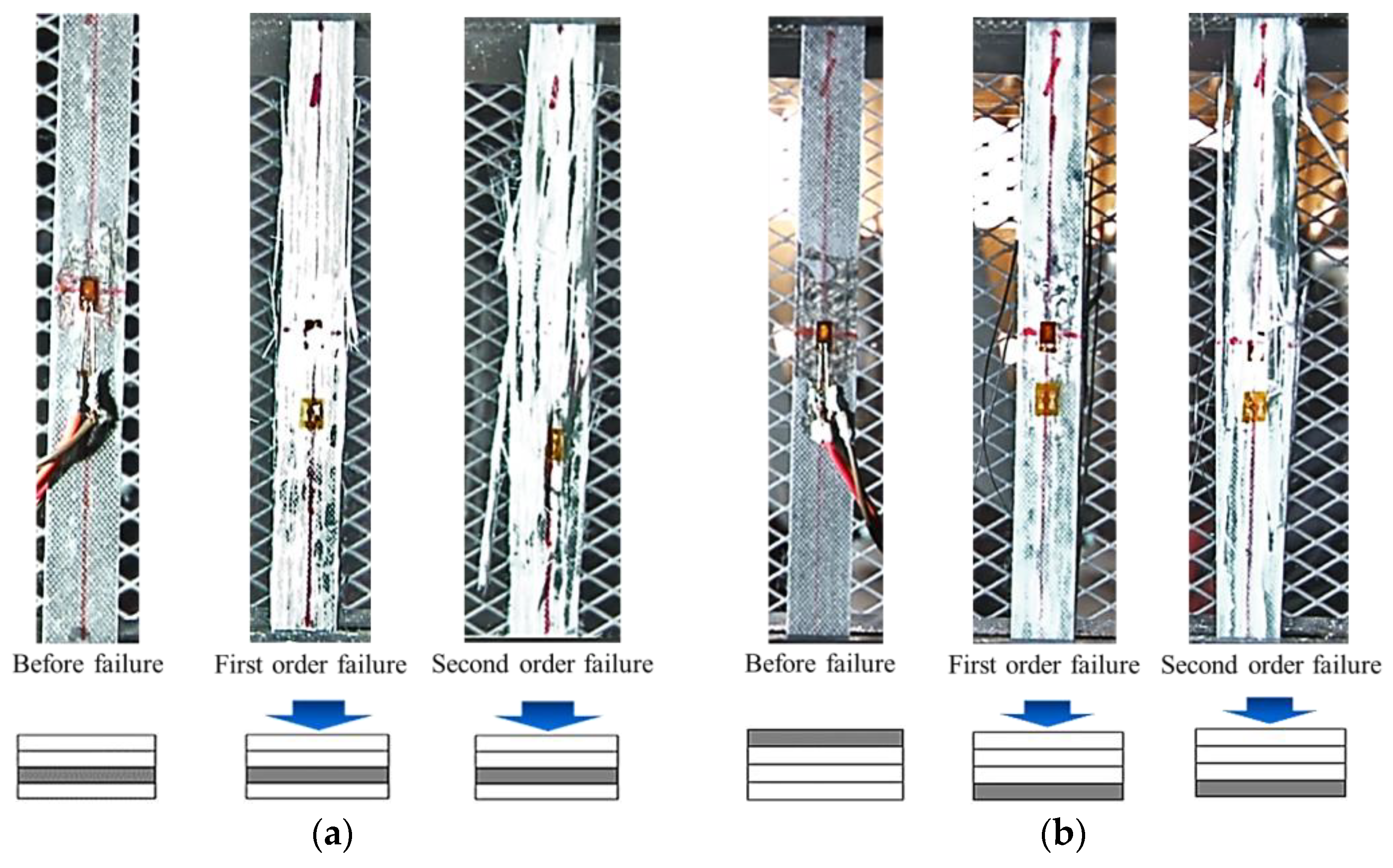
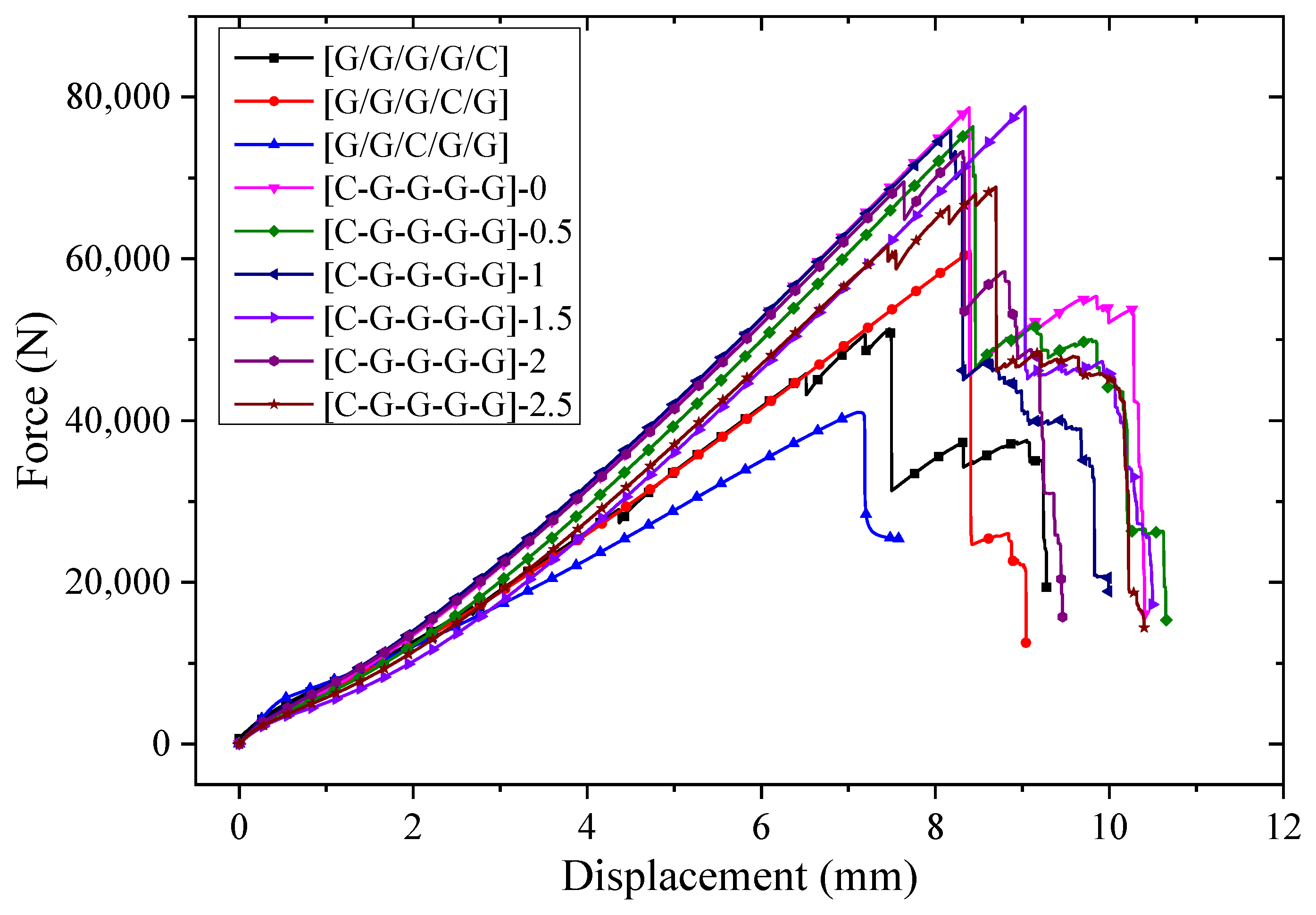
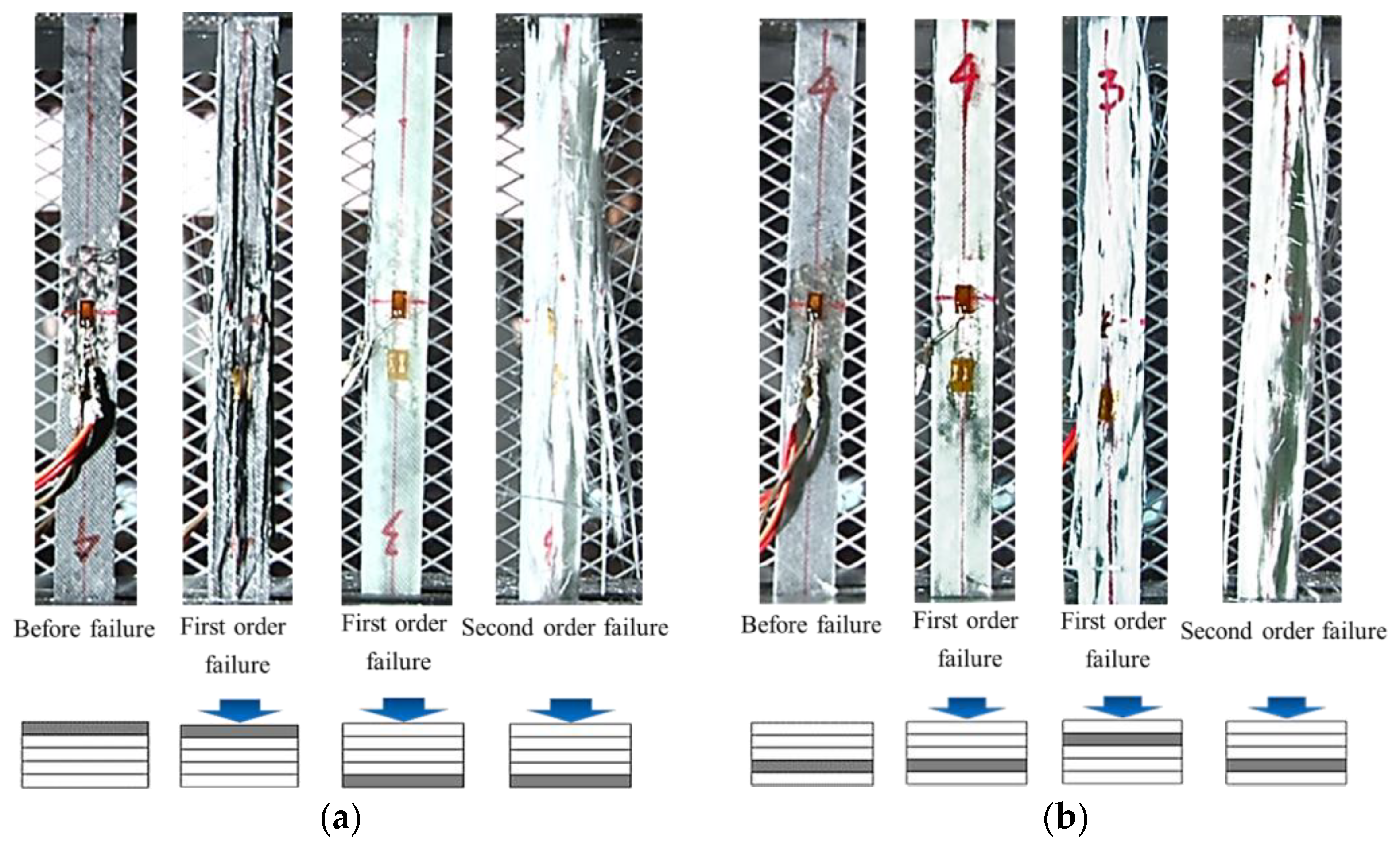


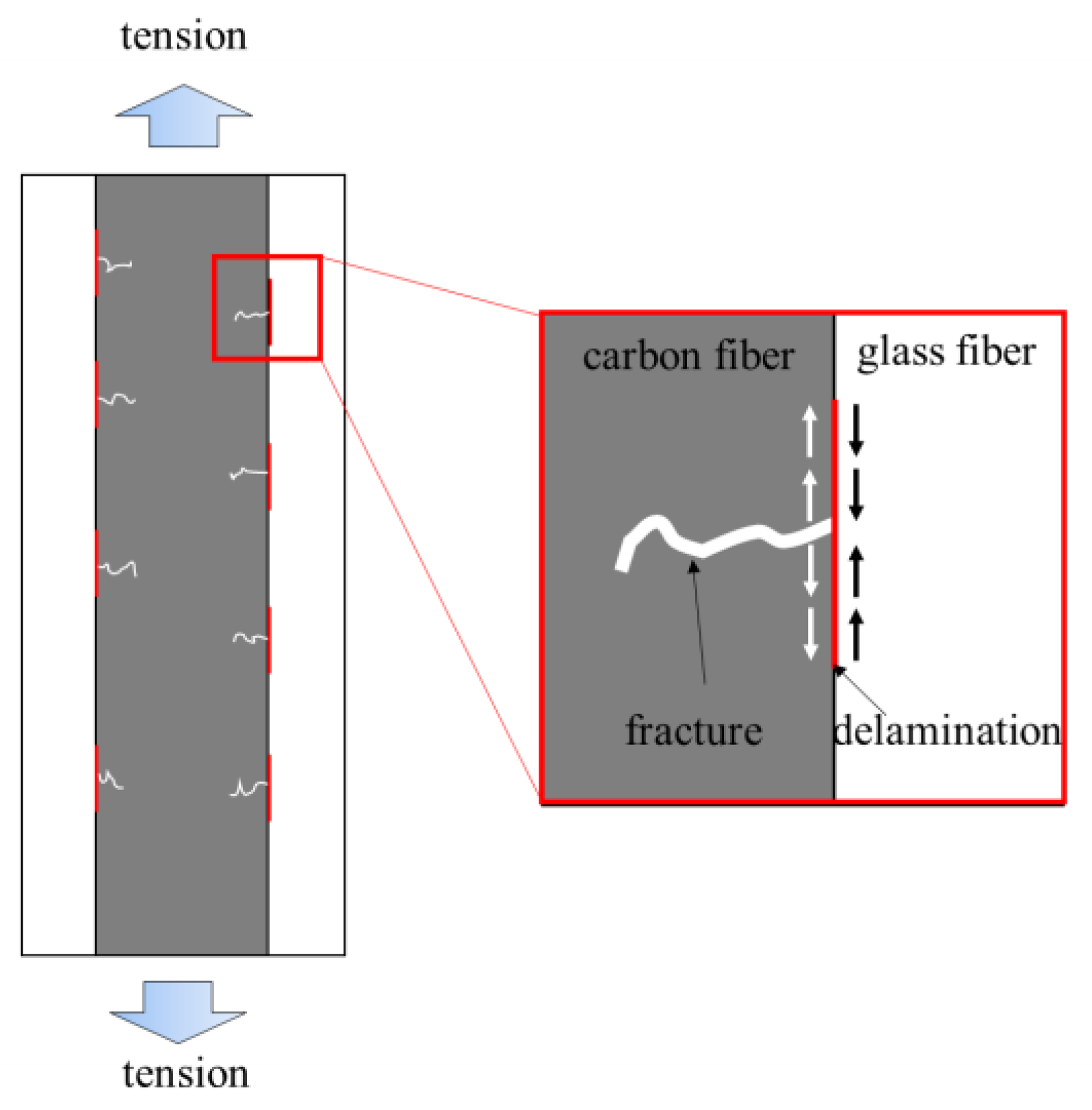


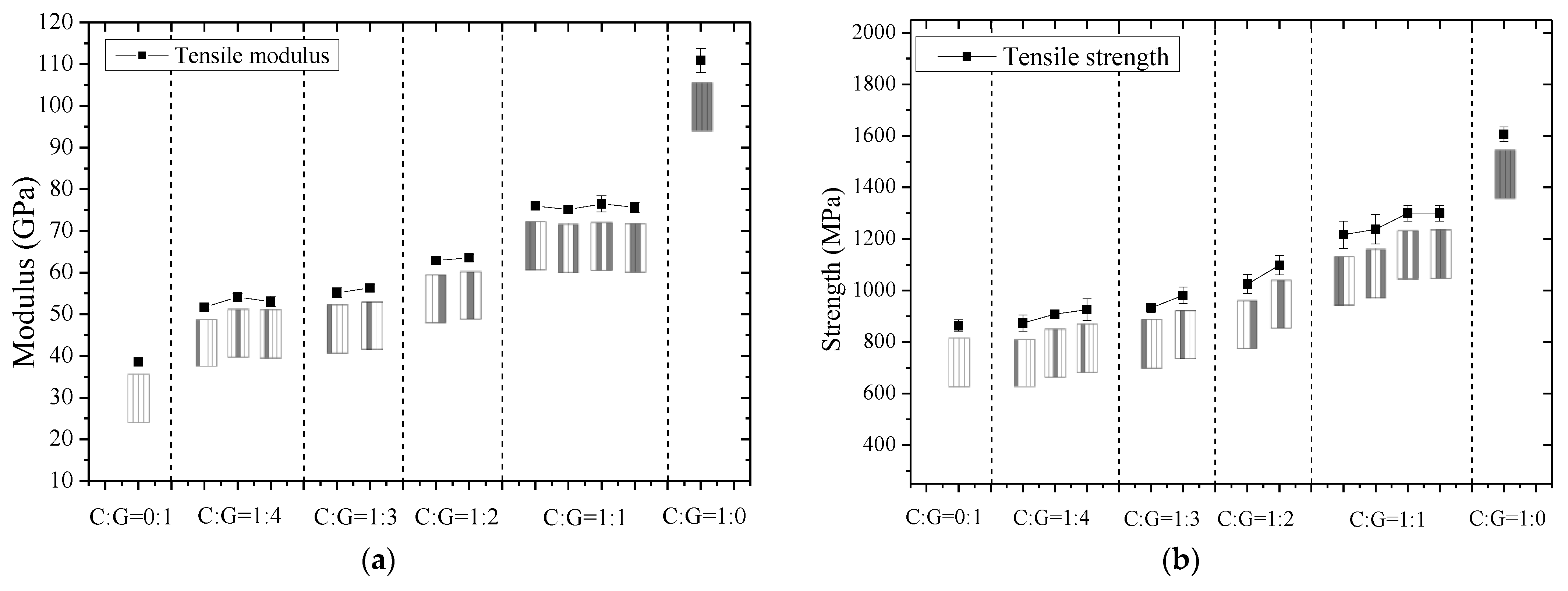
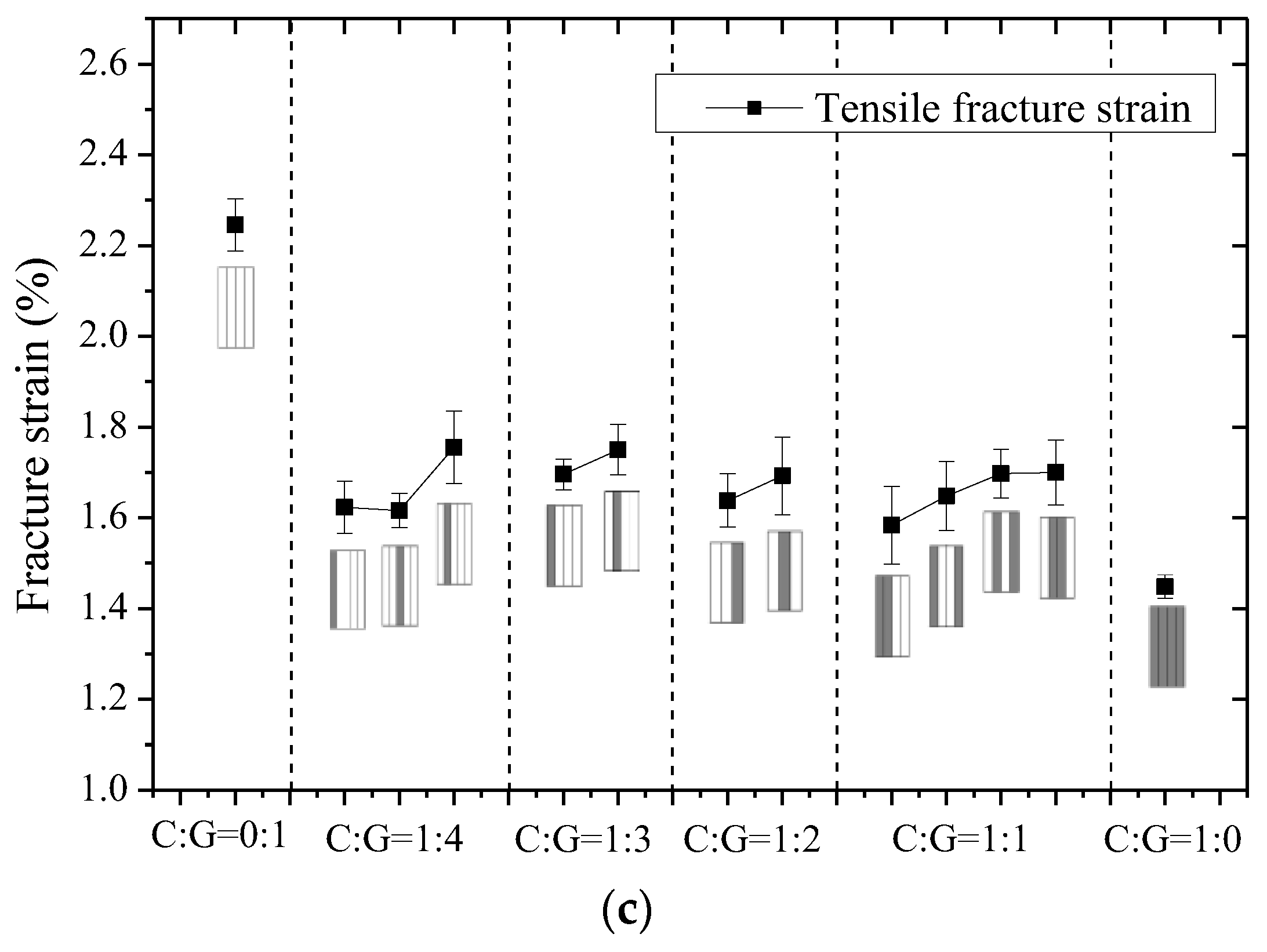

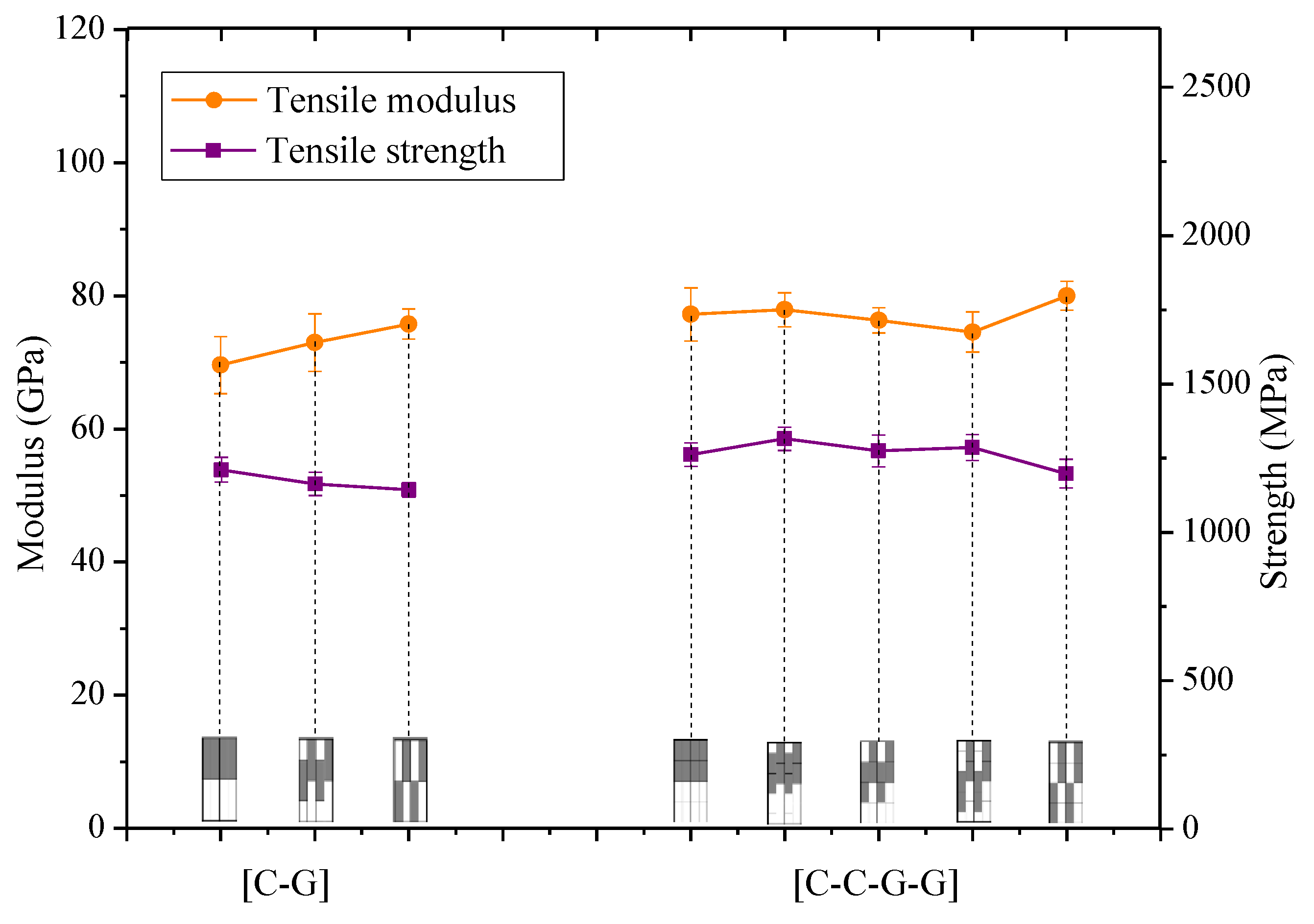


| Materials | Sources | Density (Kg/m3) | Tensile Strength (MPa) | Tensile Modulus (GPa) |
|---|---|---|---|---|
| Glass fiber | CPIC ECT469L-2400 | 2560 | 2366 | 78.7 |
| Carbon Fiber | TORAY 620SC-24K-50C | 1770 | 4175 | 234 |
| Epoxy Resin | SWANCOR 2511-1A/BS | 1100 | 73.5 | 3.1 |
| Fabric Type | Areal Density (g/m2) | Ratio of C/G | |
|---|---|---|---|
| Carbon Fiber | Glass Fiber | ||
| Carbon fabric | 728.3 | 0 | 1:0 |
| Glass fabric | 0 | 944.9 | 0:1 |
| C-G | 364.2 | 472.4 | 1:1 |
| C-C-G-G | 364.2 | 472.4 | 1:1 |
| C-G-G | 242.8 | 629.9 | 1:2 |
| C-G-G-G-G | 145.7 | 755.9 | 1:4 |
| C/G Hybrid Ratio | Stacking Sequences | |||
|---|---|---|---|---|
| 1:1 |  |  |  |  |
| [G/G/C/C] | [G/C/C/G] | [C/G/G/C] | [G/C/G/C] | |
| 1:2 |  |  | ||
| [G/G/C] | [G/C/G] | |||
| 1:3 |  |  | ||
| [G/G/G/C] | [G/G/C/G] | |||
| 1:4 |  |  |  | |
| [G/G/G/G/C] | [G/G/G/C/G] | [G/G/C/G/G] | ||
| Hybrid Fabrics | Stacking Sequences | |||||
|---|---|---|---|---|---|---|
| C-G C:G = 1:1 |  |  |  | |||
| [C-G-0] | [C-G-1] | [C-G-0.5] | ||||
| C-C-G-G C:G = 1:1 |  |  |  | |||
| [C-C-G-G-0] | [C-C-G-G-1] | [C-C-G-G-2] | ||||
 |  | |||||
| [C-C-G-G-0.5] | [C-C-G-G-1.5] | |||||
| C-G-G C:G = 1:2 |  |  |  |  | ||
| [C-G-G-0] | [C-G-G-1] | [C-G-G-0.5] | [C-G-G-1.5] | |||
| C-G-G-G-G C:G = 1:4 |  |  |  | |||
| [C-G-G-G-G-0] | [C-G-G-G-G-1] | [C-G-G-G-G-2] | ||||
 |  |  | ||||
| [C-G-G-G-G-0.5] | [C-G-G-G-G-1.5] | [C-G-G-G-G-2.5] | ||||
| Hybrid Types | C/G Hybrid Ratios | Layup Number | Total Thickness /mm | Sample Width /mm |
|---|---|---|---|---|
| Carbon fiber fabric | 1:0 | 4 | 3.2 | 15 |
| Glass fiber fabric | 0:1 | 4 | 3.2 | 15 |
| Interlayer composites | 1:1 | 4 | 3.2 | 15 |
| 1:2 | 3 | 2.4 | 15 | |
| 1:3 | 4 | 3.2 | 15 | |
| 1:4 | 5 | 4 | 15 | |
| Intralayer composites | 1:1 | 4 | 3.2 | 10/20 |
| 1:2 | 4 | 3.2 | 15 | |
| 1:4 | 4 | 3.2 | 25 |
| C/G Hybrid Ratios | Interlayer Structures | Tensile Modulus /Gpa | Error/Gpa | Tensile Strength /Mpa | Error/Mpa | Tensile Fracture Strain | Error |
|---|---|---|---|---|---|---|---|
| C:G = 0:1 | [G/G/G/G] | 38.56 | 0.30 | 863.40 | 22.08 | 2.25 | 0.06 |
| C:G = 1:4 | [G/G/G/G/C] | 51.71 | 0.69 | 873.68 | 30.89 | 1.62 | 0.06 |
| [G/G/C/G/G] | 54.13 | 0.94 | 908.52 | 10.58 | 1.62 | 0.04 | |
| [G/G/G/C/G] | 53.06 | 1.24 | 925.91 | 42.14 | 1.76 | 0.08 | |
| C:G = 1:3 | [G/G/G/C] | 55.18 | 1.16 | 932.23 | 18.82 | 1.70 | 0.03 |
| [G/G/C/G] | 56.30 | 0.71 | 981.42 | 31.30 | 1.75 | 0.06 | |
| C:G = 1:2 | [G/G/C] | 62.94 | 0.58 | 1024.49 | 36.78 | 1.64 | 0.06 |
| [G/C/G] | 63.53 | 0.88 | 1098.44 | 37.55 | 1.69 | 0.09 | |
| C:G = 1:1 | [G/G/C/C] | 76.02 | 0.99 | 1216.34 | 52.28 | 1.58 | 0.09 |
| [C/G/G/C] | 75.11 | 0.30 | 1237.89 | 57.23 | 1.65 | 0.08 | |
| [G/C/G/C] | 76.46 | 1.92 | 1299.59 | 30.86 | 1.70 | 0.05 | |
| [C/G/G/C] | 75.67 | 1.19 | 1299.97 | 31.17 | 1.70 | 0.07 | |
| C:G = 1:0 | [C/C/C/C] | 110.91 | 2.85 | 1606.44 | 28.86 | 1.45 | 0.03 |
| C/G Hybrid Ratios | Intralayer Structures | Tensile Modulus /Gpa | Error/Gpa | Tensile Strength /Mpa | Error/Mpa | Tensile Fracture Strain | Error |
|---|---|---|---|---|---|---|---|
| C:G = 1:4 | [C-G-G-G-G-0] | 51.30 | 2.55 | 942.69 | 24.86 | 1.82 | 0.04 |
| [C-G-G-G-G-0.5] | 56.06 | 1.98 | 945.50 | 27.45 | 1.69 | 0.05 | |
| [C-G-G-G-G-1] | 53.27 | 0.20 | 922.35 | 20.42 | 1.73 | 0.04 | |
| [C-G-G-G-G-2] | 59.01 | 1.72 | 917.83 | 26.26 | 1.57 | 0.03 | |
| [C-G-G-G-G-1.5] | 53.54 | 1.05 | 911.04 | 37.56 | 1.71 | 0.07 | |
| [C-G-G-G-G-2.5] | 52.71 | 1.61 | 826.74 | 8.58 | 1.56 | 0.03 | |
| C:G = 1:2 | [C-G-G-0] | 64.29 | 1.97 | 1087.71 | 23.73 | 1.69 | 0.04 |
| [C-G-G-0.5] | 62.01 | 1.70 | 1029.45 | 40.13 | 1.66 | 0.08 | |
| [C-G-G-1] | 63.99 | 1.90 | 1073.21 | 29.09 | 1.68 | 0.05 | |
| [C-G-G-1.5] | 62.70 | 3.62 | 883.99 | 22.50 | 1.43 | 0.03 | |
| C:G = 1:1 | [C-C-G-G-0] | 77.22 | 3.98 | 1262.06 | 39.82 | 1.68 | 0.02 |
| [C-C-G-G-0.5] | 77.89 | 2.55 | 1315.33 | 39.49 | 1.69 | 0.04 | |
| [C-C-G-G-1] | 76.31 | 1.91 | 1274.12 | 53.10 | 1.71 | 0.07 | |
| [C-C-G-G-1.5] | 74.54 | 3.01 | 1286.36 | 43.57 | 1.73 | 0.05 | |
| [C-C-G-G-2] | 80.01 | 2.14 | 1197.94 | 48.33 | 1.50 | 0.06 |
| Intralayer Hybrid Fabrics | Schematic Diagram of Cutting Scheme for Intralayer Hybrid Structures | ||||||||
|---|---|---|---|---|---|---|---|---|---|
| C-G |  |  |  | ||||||
| [C-G]-0 | [C-G]-1 | [C-G]-0.5 | |||||||
| C-C-G-G |  |  |  | ||||||
| [C-C-G-G]-0 | [C-C-G-G]-1 | [C-C-G-G]-2 | |||||||
 |  | ||||||||
| [C-C-G-G]-0.5 | [C-C-G-G]-1.5 | ||||||||
| C-G-G |  |  |  |  | |||||
| [C-G-G]-0 | [C-G-G]-1 | [C-G-G]-0.5 | [C-G-G]-1.5 | ||||||
| C-G-G-G-G |  |  |  | ||||||
| [C-G-G-G-G]-0 | [C-G-G-G-G]-1 | [C-G-G-G-G]-2 | |||||||
 |  |  | |||||||
| [C-G-G-G-G]-0.5 | [C-G-G-G-G]-1.5 | [C-G-G-G-G]-2.5 | |||||||
Disclaimer/Publisher’s Note: The statements, opinions and data contained in all publications are solely those of the individual author(s) and contributor(s) and not of MDPI and/or the editor(s). MDPI and/or the editor(s) disclaim responsibility for any injury to people or property resulting from any ideas, methods, instructions or products referred to in the content. |
© 2023 by the author. Licensee MDPI, Basel, Switzerland. This article is an open access article distributed under the terms and conditions of the Creative Commons Attribution (CC BY) license (https://creativecommons.org/licenses/by/4.0/).
Share and Cite
Wu, W. Tensile Failure Behaviors and Theories of Carbon/Glass Hybrid Interlayer and Intralayer Composites. Coatings 2023, 13, 774. https://doi.org/10.3390/coatings13040774
Wu W. Tensile Failure Behaviors and Theories of Carbon/Glass Hybrid Interlayer and Intralayer Composites. Coatings. 2023; 13(4):774. https://doi.org/10.3390/coatings13040774
Chicago/Turabian StyleWu, Weili. 2023. "Tensile Failure Behaviors and Theories of Carbon/Glass Hybrid Interlayer and Intralayer Composites" Coatings 13, no. 4: 774. https://doi.org/10.3390/coatings13040774
APA StyleWu, W. (2023). Tensile Failure Behaviors and Theories of Carbon/Glass Hybrid Interlayer and Intralayer Composites. Coatings, 13(4), 774. https://doi.org/10.3390/coatings13040774






